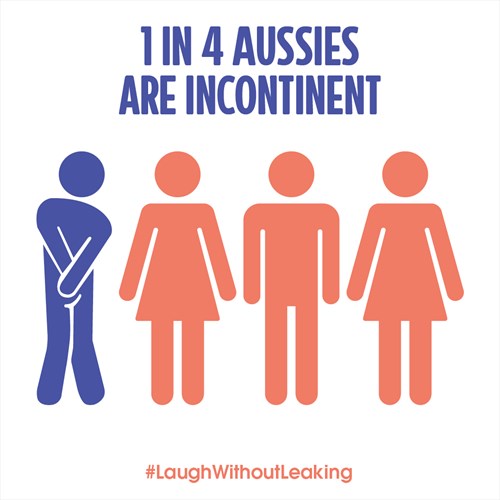
Leaking; serious information.
Many people believe that urinary incontinence (leaking wee) is just a part of having children or getting older. While these life experiences surely can be common catalysts for incontinence, the good news is that in most cases, it can be managed or treated. Don’t feel ashamed about it, in fact know that you are not alone and that 1 in 4 Australians are incontinent. So, instead of feeling embarrassed or passing it off as your inevitable normal, come seek help. Take the step to improve your quality of life and lets #LaughWithoutLeaking.
Why do I leak?
Simply put, the brain and the bladder work together to control our urinary function. The bladder stores urine until it’s ready to be emptied, then sends a signal to the brain to start hustling us towards the toilet. While we’re making our way there, the muscles of the pelvic floor help to support the bladder neck and keep the urethra (tube that carries urine out of the body) closed, ensuring the urine stays inside the bladder until we’re ready to let it flow.
When it’s time to go, the brain tells the pelvic floor muscles to relax and the muscles in the bladder to contract, which allows urine to pass out of the urethra, emptying the bladder.
When part of this process doesn’t work as planned, we end up with involuntary leakage or “urinary incontinence”.
There are two common types of urinary incontinence we tend to treat, which are “stress urinary incontinence” and “urge incontinence” (or “an overactive bladder”). Let’s take a look at how they differ.
Stress incontinence
Stress urinary incontinence is the involuntary loss of small amounts of urine during effort or physical exertion that increases intra-abdominal pressure (coughing, sneezing, walking, and lifting for example).
Undertaking activities that increase abdominal pressure and, in turn, push down on the bladder and urethra, can cause involuntarily leakage of urine. Commonly caused by pregnancy, childbirth and menopause, stress incontinence can also result from diabetes, chronic coughing, constipation and obesity
Urge incontinence/overactive bladder
Urge incontinence is the involuntary loss of urine associated with urgency (a sudden and strong need to urinate).
Typically, people with a healthy bladder will feel the need to urinate when the bladder is half full and can happily “hold on” until a time that is convenient to go to the toilet. The bladder and brain communicate well and signals to the brain for
the need to urinate are happening at appropriate times when the bladder is appropriately full.
However, for people who experience urge incontinence, the communication between bladder and brain is not functioning as it should and happens when the bladder is only partially full. When this occurs, the need to urinate is unable to be delayed; often resulting in a loss of urine before reaching the toilet.
Urge incontinence is commonly associated with the need to pass urine more frequently and can cause unwanted bladder habits like forever going to the toilet “just in case”. The effects of urge incontinence can have huge impacts on daily life and interfere with daily activities. This is where we come in.
How does physiotherapy help with incontinence?
Based on your symptoms, severity, cause and individual goals, we have plenty of tools in our physio kits to aid in managing incontinence.
Whether it’s identifying and improving pelvic floor muscle deficits, retraining the bladder and instilling or improving toileting habits, working on lifestyle modifications as well as food and fluid intake or, nerve stimulation/neuromodulation (to name a few); our physiotherapists are trained specifically in identifying the unique contributing factors of incontinence for each client and working with them to achieve the best outcome. (And no, it’s not limited to a max set of Kegels every hour on the hour; but yes, some of the exercises can be rather enjoyable).
The average adult can make around 10 trips to the toilet per day. If that means you’re not drinking enough water to avoid those trips, or those 10 trips usually make for 10 leaks (or more), you should have come to see us by now. Let us help.
~ Erin Pregarc, Physiotherapist
